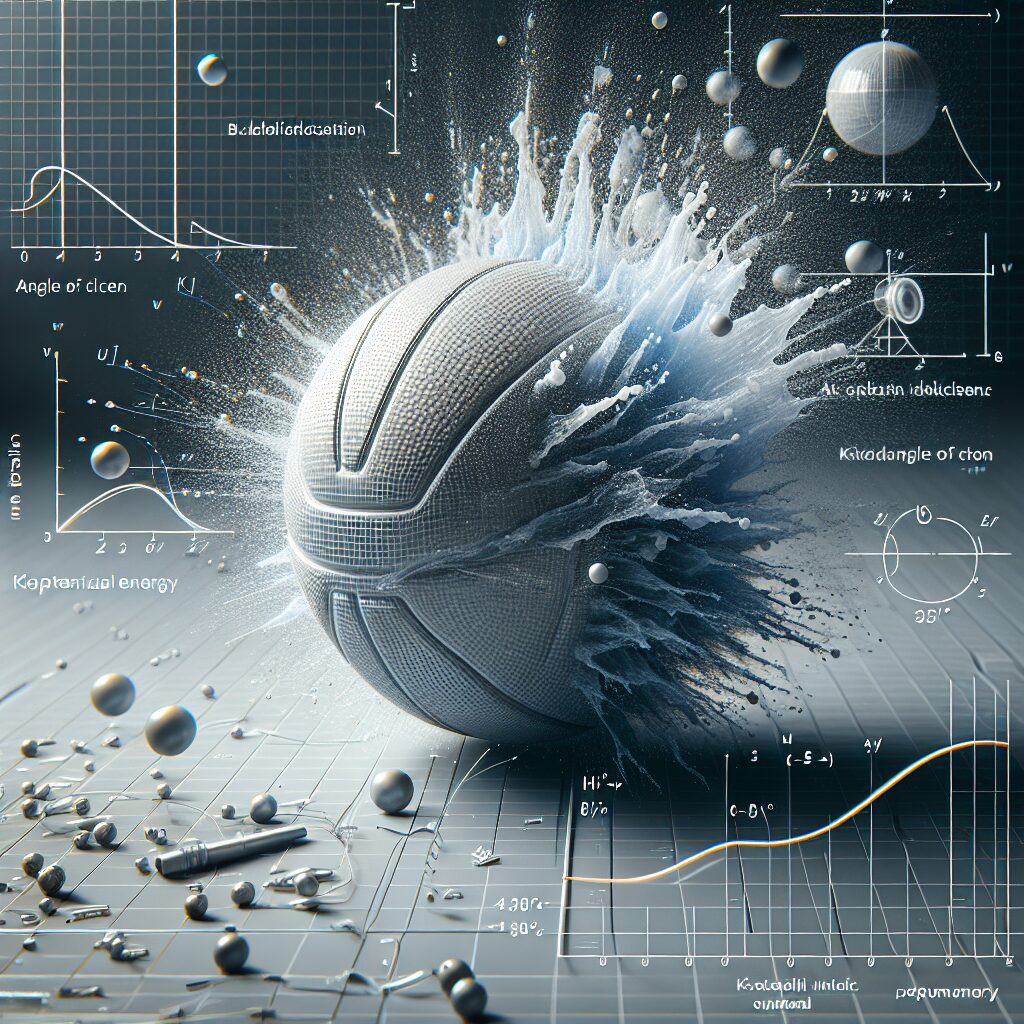Practical Applications of Bouncing Ball Physics hold a significant place in our everyday lives, more than we may realize. Understanding the intricate dynamics behind the motion of a bouncing ball can provide invaluable insights across various industries and sectors. From sports and engineering to product design and safety measures, the principles of bouncing ball physics have noteworthy impacts in each of these domains.
One fascinating aspect about bouncing ball physics is its ability to explain the behavior of objects in motion. This scientific discipline studies the motion and energy transfer of a ball as it collides with a surface and rebounds. As we delve into the applications, we begin to understand how this knowledge can be put to practical use. For instance, in the world of sports, such as basketball and tennis, understanding the physics behind ball bounce enables athletes and coaches to strategize their gameplays, optimize ball trajectory, and enhance overall performance. Similarly, engineers and designers utilize this knowledge to improve the design and efficiency of countless products, ranging from car tires to trampolines.
Moving forward, let us explore the key takeaways in our discussion of Practical Applications of Bouncing Ball Physics. We will delve into the impact of this knowledge in the realm of sports, highlighting how it influences gameplay strategies and equipment design. Additionally, we will explore its significance in the field of engineering and product development, where it enhances structural integrity and performance. Stay tuned to discover how the principles of bouncing ball physics unlock endless possibilities and revolutionize various sectors.
Key Takeaways
1. Elasticity and collision dynamics play a crucial role in understanding the physics of bouncing balls. The coefficient of restitution (COR) measures the elasticity of a ball, determining how much energy is transferred during a collision. The COR can be manipulated by altering the ball’s material or surface properties.
2. Newton’s laws of motion are essential in understanding the ball’s trajectory after a bounce. The force of gravity and the ball’s initial velocity determine its flight path, while air resistance affects its speed and direction. Utilizing these principles, engineers and designers can predict and control the ball’s behavior.
3. Bouncing ball physics finds practical applications in various fields. In sports, understanding ball behavior can improve performance, such as optimizing tennis ball bounce or soccer ball trajectory. Additionally, the study of impact dynamics is crucial in vehicle safety and accident reconstruction.
4. Materials and design choices can significantly affect a ball’s bouncing characteristics. From sports balls to industrial products, selecting the appropriate materials, such as rubber or synthetic polymers, allows precise control of elasticity, grip, and durability. Additionally, altering the ball’s internal structure, like the presence of air or liquid filling, can influence its bounce.
5. Virtual simulations and computer modeling are valuable tools in analyzing and predicting bouncing ball physics. By inputting parameters like COR, material properties, and initial conditions, scientists and engineers can simulate complex scenarios and virtually test different designs. This approach saves time, resources, and allows for innovative advancements in ball-related industries.
What are the practical applications of bouncing ball physics?
Understanding the Science Behind Bouncing Balls
Bouncing ball physics is a fascinating field that delves into the principles governing the behavior of bouncing balls. By studying this phenomenon, scientists and engineers are able to unravel the underlying mechanics and apply them to various practical applications.
1. Sports Equipment Design
Bouncing ball physics plays a crucial role in designing sports equipment, especially balls used in sports like basketball, football, and tennis. By understanding how balls bounce and interact with different surfaces, manufacturers can optimize the design and materials to enhance performance and ensure fair play.
2. Engineering of Shock Absorbers
The principles of bouncing ball physics are vital in engineering shock absorbers for various applications. From car suspensions to building foundations, understanding how balls bounce helps in designing effective shock-absorbing mechanisms that mitigate impact and prevent damage.
3. Construction of Artificial Turf
Bouncing ball physics is also relevant in the construction of artificial turf surfaces. By studying how balls interact with different types of turf, engineers can create surfaces that provide consistent bounce, optimizing gameplay in sports like soccer or hockey.
4. Animation and Graphics Development
The animation and graphics industry heavily relies on bouncing ball physics to create realistic motion. By accurately simulating ball bounces, animators and game developers bring characters and objects to life, providing a visually immersive experience for audiences.
5. Collision Detection Algorithms
In computer science, collision detection algorithms are crucial for various applications, such as video games and virtual reality simulations. The principles of bouncing ball physics are utilized to accurately detect and respond to collisions between objects, enhancing realism and interactivity.
6. Ballistics and Projectile Motion
Understanding bouncing ball physics also aids in the field of ballistics and projectile motion. By analyzing how balls bounce after impact, engineers and physicists can predict trajectories, optimize projectile designs, and enhance accuracy in fields like military weaponry or sports training.
7. Education and Science Outreach
The practical applications of bouncing ball physics extend beyond technical fields. Educators and science communicators utilize these principles to engage students and the general public in hands-on experiments and demonstrations. Through interactive activities, bouncing ball physics fosters a deeper understanding of fundamental physics concepts.
8. Vibrational Energy Harvesting
Bouncing ball physics is also crucial in the development of vibrational energy harvesting systems. By harnessing the energy generated during ball bounces, engineers can convert it into usable electrical energy, leading to potential applications in renewable energy generation.
9. Study of Material Properties
Researchers leverage bouncing ball physics to gain insights into material properties. By observing how balls bounce on different surfaces, scientists can analyze factors like elasticity, rebound, and friction, providing valuable data for material science and engineering.
10. Recreation and Entertainment
Lastly, bouncing ball physics finds its application in various recreational and entertainment activities. From simple games like ping pong or billiards to complex ball-based performances like juggling or trick shots, understanding the physics behind bouncing balls enhances enjoyment and pushes the boundaries of human skill.
Top Tips for Practical Applications of Bouncing Ball Physics
- How can bouncing ball physics improve the design of sports equipment?
- What role does bouncing ball physics play in the construction of artificial turf?
- How does understanding bouncing ball physics aid in animation and graphics development?
- What are the applications of bouncing ball physics in collision detection algorithms?
- How can bouncing ball physics enhance accuracy in ballistics and projectile motion?
- What educational and science outreach programs can benefit from practical applications of bouncing ball physics?
- What potential does bouncing ball physics hold in vibrational energy harvesting?
- Which insights can be gained from studying material properties through bouncing ball physics?
- How does bouncing ball physics contribute to recreational and entertainment activities?
Frequently Asked Questions
1. How is bouncing ball physics applicable in sports?
Bouncing ball physics plays a crucial role in various sports, such as basketball, tennis, and soccer. Understanding the principles of ball elasticity, collision, and kinetic energy helps athletes improve their game strategies and enhance ball control. It enables players to predict the ball’s trajectory, optimize their movements, and make accurate shots or passes.
2. Can bouncing ball physics be utilized in engineering projects?
Absolutely! Engineering projects often involve the design and development of products or systems that require knowledge of bouncing ball physics. Engineers use these principles to design shock absorbers, suspension systems, or even create models for simulating the behavior of vehicles or machinery involved in rebounding and collision scenarios.
3. How does bouncing ball physics apply to architecture and construction?
Bouncing ball physics is applicable in architecture and construction when designing structures or spaces that need to absorb or redirect impact forces. For instance, materials with certain elasticity properties are used to minimize damage or vibrations caused by earthquakes or other external impacts. Understanding how materials behave when subjected to bouncing ball physics helps architects and civil engineers create safer and more durable buildings.
4. Can bouncing ball physics be applied to video game development?
Yes, bouncing ball physics is widely used in video game development. Implementing realistic ball physics adds a touch of authenticity to games, making gameplay more engaging and challenging. Game developers utilize bouncing ball physics to create lifelike ball movements, reactions to collisions, and accurate simulations of physical interactions between objects.
5. How can bouncing ball physics be useful in the field of cinematography?
In cinematography, filmmakers often utilize practical effects that involve bouncing balls to create captivating scenes. Understanding bouncing ball physics aids in achieving believable special effects and helps with the planning and execution of complex shots involving ball movements, collisions, or interactions with other elements in the scene.
6. How can knowledge of bouncing ball physics enhance product design?
Bouncing ball physics knowledge is advantageous in product design, especially for items that involve impact or require controlled bouncing, such as balls used in sports or toys. Designers can optimize the materials, size, shape, and elasticity of the product to achieve the desired bouncing characteristics and improve overall user experience.
7. Does bouncing ball physics have any applications in the field of robotics?
Yes, bouncing ball physics is relevant in robotics and robotic motion planning. Understanding how a robot’s movements interact with a bouncing ball allows engineers to design robotic systems capable of interacting with dynamic environments. This knowledge helps in tasks such as object manipulation, path planning, and collision avoidance.
8. Are there any medical applications related to bouncing ball physics?
Medical applications of bouncing ball physics can be seen in fields like physiotherapy and prosthetics. Rehabilitative exercises involving bouncing balls help patients improve balance, coordination, and muscle strength. In prosthetics, understanding how a bouncing ball interacts with various surfaces helps in designing artificial limbs that provide natural and stable movements.
9. How does bouncing ball physics apply to the field of materials science?
Bouncing ball physics plays a role in materials science, as it helps researchers analyze the properties of different materials. By studying how a ball bounces off various surfaces coated with different materials, scientists can determine material elasticity, friction, and impact resistance, guiding the development of new materials for diverse applications.
10. Can bouncing ball physics have any impact on mathematics education?
Absolutely! Integrating bouncing ball physics into math education can make learning more interactive and applicable. By exploring ball trajectories, students can understand concepts of motion, velocity, acceleration, and mathematical relationships between variables. It allows for practical and tangible demonstrations, making math more engaging and relatable.
Final Thoughts
Practical applications of bouncing ball physics extend far beyond what meets the eye. From sports and engineering to cinematography and robotic motion planning, this fundamental concept is broad and versatile. Its understanding enhances various industries, leading to improved designs, more accurate simulations, and creative problem-solving. By appreciating the practical applications of bouncing ball physics, we can unlock new realms of innovation and pave the way for exciting advancements in countless fields.
Bouncing ball physics is not only fascinating but also provides a solid foundation for understanding and analyzing complex physical interactions. Its interdisciplinary nature bridges gaps between different disciplines, enabling ideas and principles to be seamlessly adapted across industries. Whether you’re a sports enthusiast, a designer, or a scientist, embracing the practical applications of bouncing ball physics opens doors to endless possibilities and encourages continuous learning and innovation.




